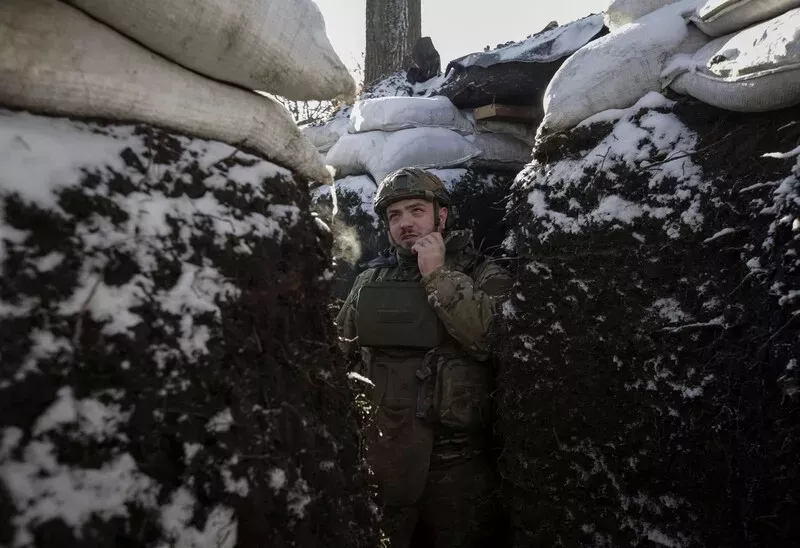
Back in 2013, Russian Gen. Valery Gerasimov succinctly stated the nightmare problem he now faces as the newly installed leader of Russia’s bungled war against Ukraine: “You cannot generate ideas on command”.
Gerasimov, the chief of staff of the Russian military, this month was given the thankless task of directing Russian forces in Ukraine. Since Gerasimov helped plan the botched invasion last February, this might seem like doubling down on failure. But U.S. analysts believe that Gerasimov has promised his boss, President Vladimir Putin, that he will employ more aggressive tactics to regain the initiative.
The Gerasimov appointment comes as Ukraine, too, is moving to use new weapons and tactics to break out of what has become a bloody stalemate. For both sides, 2023 will see attempts to redraw largely static battle lines. A front line of World War I-style trenches might become a more fluid and unpredictable battlespace this year.
Gerasimov dreamed a decade ago of modernizing the Russian military to conduct this sort of modern battle. In a widely read 2013 article, he said that “the very ‘rules of war’ have changed”. Russia’s traditional brute force tactics were outmoded. “Frontal engagements of large formations of forces … are gradually becoming a thing of the past”. Instead, he argued, Russia needed “speed, quick movements, the smart use of paratroops and encircling forces”, along with irregular “hybrid” forces to fight behind the lines.
It didn’t work out the way Gerasimov and Putin hoped, to put it mildly. Russia tried its version of a lightning strike to capture Kyiv. But it hadn’t reckoned on Ukrainian valor or Russian incompetence. Since the failure of Putin’s plan to quickly seize the capital, Russian forces have repeatedly retrenched and retreated.
Putin, who sells himself as a decisive leader, has instead been reactive, with decisions forced on him by battlefield reversals. After Ukrainian forces retook Kharkiv in a bold September counteroffensive, Putin hastily “annexed” four regions where Russia’s hold was precarious. After Ukrainian special operations forces bombed the Kerch Strait bridge to Crimea in October, a desperate Putin launched a missile assault on Ukraine’s civilian infrastructure that continues to this day.
The appointment of Gerasimov is Putin’s latest Hail Mary pass, and U.S. officials doubt it will succeed. The biggest problem is the chaotic command structure under him. Hastily trained conscripts are being rushed to the front as little more than cannon fodder. Meanwhile, the Wagner militia, led by catering oligarch Yevgeniy Prigozhin, has taken a lead role in the bitter but strategically meaningless battle for Bakhmut in eastern Ukraine.
It’s a crazy time for the Russian military: When a Wagner soldier posted a profane video in December denouncing Gerasimov, Prigozhin dug the knife in deeper by posting: “The guys asked me to pass along, that when you’re sitting in a warm office, it’s hard to hear the problems on the front line”. Remember, this Wagner front line is manned partly by ex-convicts who have been promised that if they survive, they might get their freedom. What an army.
Amid this backbiting, amplified by Russian military bloggers, Putin decided to hand Gerasimov the poisoned chalice of direct command. The man he will replace, Gen. Sergei Surovikin, is said to have counseled caution in protecting the Russian army in Kherson and elsewhere — and was also friendly with Prigozhin.
Gerasimov will try to restore military order among bickering commanders and also initiate complex operations of the sort he envisioned in 2013. One expert skeptically recalls a Russian proverb: “He can’t outleap himself”.
As the new year dawns, Ukraine appears to be generating momentum. The United States and its NATO allies are providing a new arsenal of mobile weapons — tanks and heavy armored vehicles that would, in theory, allow the Ukrainians to conduct American-style maneuver warfare. Just as important, NATO is providing Ukrainian soldiers with a crash course in using these weapons effectively.
“This is one of those moments in time where if you want to make a difference, this is it”, Gen. Mark A. Milley, chairman of the Joint Chiefs of Staff, told American trainers in a visit Monday to a camp in Germany, where Ukrainian soldiers are getting a rush education in what the Pentagon likes to call “combined arms operations”.
A big question is whether the Ukrainians will have enough mobile firepower to conduct the kind of maneuver warfare that NATO commanders advocate. So far, the United States has promised about 50 Bradley fighting vehicles, Germany has pledged about 40 Marder fighting vehicles and Britain has pledged 14 Challenger tanks. That’s not even close to the 300 tanks that Gen. Valery Zaluzhny, the Ukrainian commander, has requested.
More mobile armor might be on the way with the possibility that Germany will release scores of Leopard tanks and Washington will provide Stryker combat vehicles. I hope so. This year might prove decisive in Ukraine. Having wisely urged Ukraine to adopt maneuver warfare against Gerasimov’s battered, bunkered forces, the United States and its allies shouldn’t support this effort halfway. The West has a strategy: So, go for it.
David Ignatius writes a twice-a-week foreign affairs column for The Washington Post. His latest novel is “The Paladin”.
